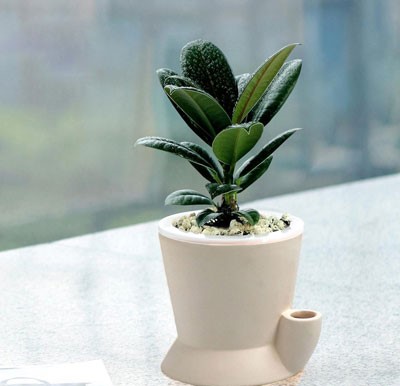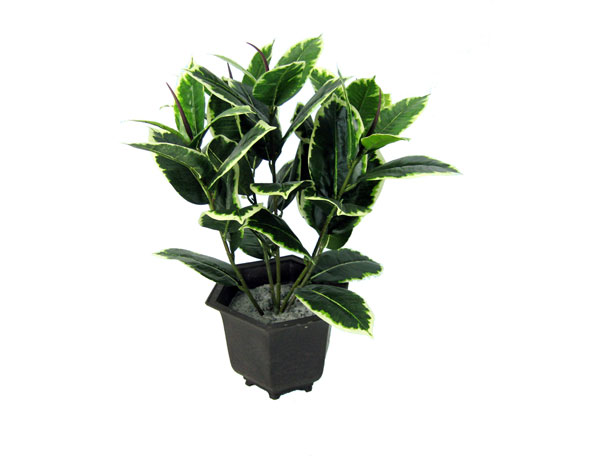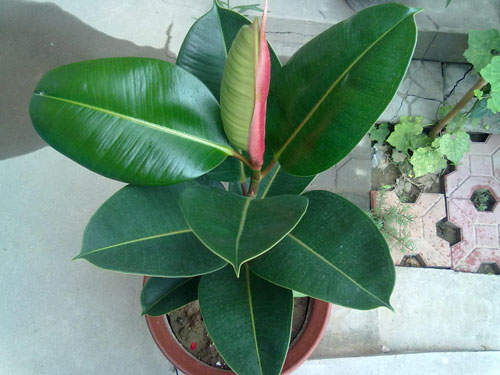Rubber Tree Plant (Rubber Fig) Care & Growing Guide
Written by Iris
Oct 29 2021

Rubber tree plant, also called Rubber Fig, Ficus elastica, has thick and wide leaves with a dark green color. The top buds are bright red and it has an obvious trunk and fewer branches. The leaves are oval, bright green, with multiple and parallel lateral veins, red young leaves, and stout petioles; Rubber Fig trees are of high ornamental value and are well-known potted foliage plants. It is very suitable for indoor beautification layout. Small and medium-sized plants are often used to beautify living rooms and study rooms; medium and large-sized plants are suitable for arrangement on both sides of the entrance hall and the center of the lobby of large buildings. This article will introduce all aspects of Rubber Fig that you are interested in.
If you live in zones 10 through 12, you can also grow rubber fig plants outside in both sunny and shady areas. Rubber trees growing outdoors in rich, well-draining soil can get pretty big (20 to 30 feet tall), so be sure to plant them they can spread out a bit—or plan to prune them.
In their dormant season in the winter you want to keep the soil dry but not too dry. Let the top few inches of the soil dry in between watering to make sure you don’t over water. If the leaves start to droop, then your rubber plant is telling you it needs more water.
If you're looking to give your Rubber Fig tree a boost during the growing season, do so with a regular monthly fertilizer during the spring and fall with a half-diluted indoor plant fertilizer in either liquid or slow-release form.
Rubber Tree Plant InfoWhere to Grow Rubber Tree PlantHow to Grow Rubber Tree PlantHow to Care for Rubber Tree PlantRubber Plant Lighting RequirementsRubber Plant Soil CareRubber Plant WateringRubber Plant Temperature & Humidity CareRubber Plant FertilizerRubber Plant PruningRubber Plant Pests & Diseases CareVarieties of Rubber Plant Rubber Tree Plant Care FAQAre Rubber Plants difficult to care for?Why are the leaves of Rubber Fig dropping?Can I place my Rubber tree next to an AC or heating vent?How often should I fertilize Rubber Fig?How often does my Rubber Fig need to be repotted?
Rubber Tree Plant Info
| Botanical/Scientific Name | Ficus elastica |
| Common Name | Rubber plant, rubber tree, rubber fig |
| Plant Type | Evergreen tree |
| Sun Exposure | Partial shade |
| Soil Requirments | Acidic, moist but well-drained soil |
| Bloom Time | Rarely blooms |
| Native Area | Asia |
| Toxicity | Weakly poisonous to dogs and cats |
| Uses | Indoor trees, Winter garden, potted plants, etc |
Where to Grow Rubber Tree Plant
While Rubber Fig plants prefer bright, indirect light (like the kind that streams in through south- or west-facing windows), they will also grow in dimmer light, which makes them fantastic office plants. They really aren’t too picky about light aside from the fact that harsh, direct light can sunburn them. Rubber tree plants are native to tropical areas, so they don’t like to be hit with cold blasts of air from doors or drafty windows, and may begin to drop some leaves if they are.If you live in zones 10 through 12, you can also grow rubber fig plants outside in both sunny and shady areas. Rubber trees growing outdoors in rich, well-draining soil can get pretty big (20 to 30 feet tall), so be sure to plant them they can spread out a bit—or plan to prune them.
How to Grow Rubber Tree Plant
You can propagate additional plants from your Rubber Fig Plant while it’s actively growing through the warm months of spring throughout summer. The propagation steps are basic and even those with black thumbs should have success.- Using clean pruning tools snip off about a 4- to 6-inch section from the end of a Rubber tree branch.
- Snip off all the leaves other than the top one or two. This allows the cutting to put its energy into forming new roots and not into developing new leaves.
- Since the cut section will exude its milky sap, allow the cutting to rest for about 30 minutes before potting.
- Fill a 6-inch to 1-gallon container that has bottom drain holes with a lightweight potting mix, or seed-starting mixture. Water the soil in the container so it settles.
- Make a several inch indentation in the center of the pot where the end of the cutting will be inserted.
- Before planting the Rubber Plant cutting, dip the cut end in a rooting hormone.
- Place the cut end treated with the hormone into the center hole and firm the soil around it using your fingers.
- Water the soil again and until it runs from the bottom drain holes. Keep the soil moist but not soggy while the cutting develops roots.
- Place the container in an indoor location that receives bright, indirect sunlight.
How to Care for Rubber Tree Plant
Rubber Plant Lighting Requirements
Rubber Fig plants prefer bright, indirect light that isn’t too hot. Direct sunlight can result in scorched leaves. You can keep your Rubber tree plant near a window with a sheer curtain to give it just the right amount of sunlight. The more variegated varieties need more light to help bring out their colors, so make sure they especially get enough bright light.Rubber Plant Soil Care
When it comes to their soil composition, Rubber Fig plants aren't picky. Typically, any good, fast-draining potting soil will likely do—many indoor gardeners opt for a cactus mix. In addition, rubber plants prefer an acidic soil mixture. Like fiddle leaf fig trees (which many believe they resemble), they also "eat" their soil and will eventually have their roots exposed. When this happens, simply top your pot with additional soil and it will not be an issue.Rubber Plant Watering
Rubber plants require more water during their growing season in the summer. You should keep the soil moist, but not drowning. You should also wipe the leaves down with a damp cloth to keep them moist and to help your plant absorb more sunlight. Misting is another option if you don’t want to wipe down every leaf. Keep your Rubber Fig plant in well-draining soil at all times to combat root rot.In their dormant season in the winter you want to keep the soil dry but not too dry. Let the top few inches of the soil dry in between watering to make sure you don’t over water. If the leaves start to droop, then your rubber plant is telling you it needs more water.
Rubber Plant Temperature & Humidity Care
Rubber tree plants generally prefer temperatures between 60°F to 75°F. In the winter, they can survive in temperatures as low as 50°F. Just like with water and sun needs, a good balance of temperature is ideal for this plant’s growth. It prefers moist and humid air due to its tropical origin, but can survive in less humid temperatures. Rubber Fig plants are sensitive to temperature changes and prefer to live in areas with consistent humidity and temperature.Rubber Plant Fertilizer
According to Clemson University's Home and Garden Information Center, it's important to fertilize regularly with a water-soluble houseplant fertilizer during active growth in the warmer months. This should be done every two weeks—unless plants are growing in lower light, then they should be fertilized less frequently.If you're looking to give your Rubber Fig tree a boost during the growing season, do so with a regular monthly fertilizer during the spring and fall with a half-diluted indoor plant fertilizer in either liquid or slow-release form.
Rubber Plant Pruning
You’ll need to prune your Rubber Fig plant to help it support itself, promote new growth and control its size so that it doesn’t grow too large. It’s best to prune in the spring and to avoid the winter, but a Rubber Fig plant can be pruned at any time of the year. Be aware that cutting the branches will release some of the plant’s sap.Rubber Plant Pests & Diseases Care
Rubber Fig plants are vulnerable to a variety of pests that typically infest indoor houseplants, including aphids, mealy bugs, spider mites, scale, and thrips. If possible, identify the infestation as early as possible and treat it with the least toxic option, like neem oil.Varieties of Rubber Plant
These are attractive indoor trees that make an eye-catching statement, with their large, glossy leaves ranging around a foot long and 5 inches across. The standard Rubber Fig Plant’s leaves are solid green, but you also have choices in the various cultivars that pump up the color on the foliage. Some of the various varieties of Rubber Fig Plants include:‘Decora’ Rubber Plant
Has dark green foliage with a white midrib.‘Rubra’ Rubber Plant
Has dark green foliage with a red midrib.‘Tricolor’ Rubber Plant
Has green leaves with patches of pink and cream.‘Robusta’ Rubber Plant
Produces larger green leaves that grow around 18 inches long.‘Doescheri’ Rubber Plant
Produces variegated leaves in gray and cream with pink ribs.‘Variegata’ Rubber Plant
Produces smaller leaves variegated in yellow and green.‘Foliis Aureo-marginata’ Rubber Plant
Has gold margined leaves.Rubber Tree Plant Care FAQ
Are Rubber Plants difficult to care for?
The Ficus Elastica is easier to care for than its sister plant, the Ficus lyrata (Fiddle Leaf Fig tree). It acclimates well to new spaces, it’s less finicky when it comes to water, and it doesn’t need quite as much light. We consider it a medium level plant in terms of difficulty to care for.Why are the leaves of Rubber Fig dropping?
Typically this is caused by either over or underwatering. If your Rubber Fig tree is showing brown tips with yellow edging, and dropping from the lower portion of the plant then you are likely over watering. If you see fully yellow leaves, and some crispy brown tips without yellow edging then it is likely due to underwatering. Always feel the soil to see if its conditions match your diagnosis, and consider the recent care you have given.Can I place my Rubber tree next to an AC or heating vent?
It is best not to. Rubber Fig plants are sensitive to hot and cold air drafts. They prefer humidity and warm temperatures, so anything to aid in maintaining a tepid environment will help keep your plant happy and healthy.How often should I fertilize Rubber Fig?
In general, house plants will thrive when they are fertilized spring through fall. Fertilize Rubber Fig once a month with an organic houseplant fertilizer, following the package instructions for dilution and administration. Greenery NYC uses an organic potting mix with a slow release fertilizer in the soil, so your plant will not need fertilizer within the first 6 months of receiving it.How often does my Rubber Fig need to be repotted?
For smaller desktop plants, we suggest repotting Rubber Fig once every 12-18 months. Typically you want to choose a potting vessel 1”- 2” larger in diameter to allow for growth. Don’t choose a pot much larger than the previous as this could drown the plant's roots. If you prefer to maintain the current size of your plant, repot into the same vessel, providing new soil and trimming away some roots and foliage. Spring or summer is the ideal time to repot as the plant is at its strongest.Latest Updated
- Benefits of Bugleweed - 7 Science-backed Health Benefits
- Bugleweed Dangers & Side Effects - Is It Poisonous?
- How to Plant Evergreen Trees - What You Should Know
- When to Plant Evergreens - Grow Guide for Evergreen Trees
- 12 Wonderful Evergreen Shrubs for Your Garden
- 12 Popular Evergreen Plants with Pictures for Beginners
- When And How To Prune A Lilac Bush Like a Pro
- How to Grow & Care for Lilac Vine (Hardenbergia Violacea)
- Japanese Lilac Tree (Syringa Reticulata) Care & Propagation Guide
- Shumard Oak Pros and Cons - What to Know
Popular Articles
- Winter maintenance of Antirrhinum Majus
- How to Grow Terminalia Mantaly Tree
- How to Grow and Care for Crossostephium Chinense
- How to grow Antirrhinum Majus in spring
- Peristeria Elata (Dove Orchid) Profile: Info & Care Guide
- Underwatered Snake Plant (Sansevieria Trifasciata) - Signs And How To Fix
- How to Care for Brazilian Jasmine Plant (Mandevilla Sanderi)
- How to Grow & Care for Graptopetalum Purple Delight in Summer
- Rosa Chinensis (China Rose): Plant Growing & Care Tips
- How to Care for Baby Sun Rose (Aptenia Cordifolia)

